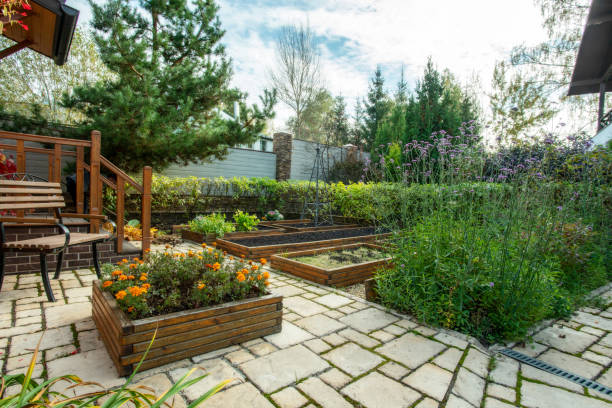Before your own garden becomes a place of retreat and relaxation in the first days of spring, some gardening needs to be done. Therefore, you should create a vegetable patch in the spring. But planning the vegetable patch can begin as early as winter.
Create vegetable beds in the garden
A healthy diet includes dishes with vegetables. A small garden also offers the opportunity to grow vegetables. However, the vegetable patch must be properly planned, laid out, and regularly maintained. You can grow different types of vegetables in your own vegetable garden. And then use it for healthy cooking. Every hobby gardener knows how good their own vegetables from the garden taste. So start planning early and make sure you have the right equipment for gardening. Consequently, we have collected the most important tips for creating a vegetable patch.

1) Plan a vegetable patch
So that freshly sown plants do not freeze to death overnight, ground frost must not occur before sowing. So don’t start planting the vegetable patch until spring. However, you can start planning your own vegetable garden in winter. For this purpose, first, create a planting plan. Expertise in vegetable cultivation and mixed cultures is an advantage. However, you can easily find out more about growing vegetables in advance on the Internet or in magazines. You can also order the necessary equipment and clever tools for gardening online.
2) Which vegetables to use for the vegetable patch?
When creating a vegetable bed in your own garden, it is important to pay attention to which vegetables are in season and at what time. In addition, a mixed culture table from the Internet shows you which types of vegetables you can combine well with each other. This is important because you should plant different types of vegetables next to each other in a vegetable patch.
3) Determine the size of the bed
Before creating vegetable beds, the size of the vegetable garden and the individual beds must first be determined. When designing the garden, most hobby gardeners opt for a rectangular or square shape. A vegetable bed is about 80 to 120 centimeters long. However, it is also possible to create narrower vegetable beds so that the marked ground does not have to be walked on when tending. Also, note important tasks in the garden in winter.
4) Choose a suitable location and construct a bed edging
In order for your vegetables to thrive, you should choose a sunny and wind-protected place for your vegetable patch. You can build the bed edging with different materials. You can also use wooden boards, stones, or old slatted frames for this. When using slatted frames as a bed edging, carefully separate the individual slats and place them next to each other as a border for the vegetable bed.
5) Prepare the soil in front of the vegetable patch
But before planting vegetables, you need to prepare the soil. If the soil stores a lot of water and is well aerated, the plants can optimally develop roots. Therefore, dig up the soil spade deep and mix it with vegetable soil or fresh compost. This loosens the soil and you can start sowing. In addition, you should pay attention to sufficient safety when doing any gardening work.

6) Sowing tips for planting
Seed tapes are very helpful when creating a vegetable garden. With these products, the seeds are in a paper band, making it easier for you to sow. The tape will later decompose by itself in the soil. But before sowing, you should level the soil again and water it. Then plant the young vegetable plants directly in the vegetable patch. Depending on the vegetable crop, you can also use seedlings. After planting the plants or seeds, cover them with some soil and water them again. With regular care, you can soon be harvesting healthy vegetables that you have grown yourself. Then you can grill the vegetables or make delicious smoothies yourself.
















